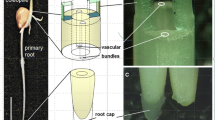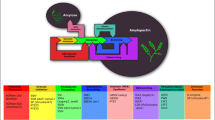Abstract
Plants’ ability to sense and respond to gravity is a unique and fundamental process. When a plant organ is tilted, it adjusts its growth orientation relative to gravity direction, which is achieved by a curvature of the organ. In higher, multicellular plants, it is thought that the relative directional change of gravity is detected by starch-filled organelles that occur inside specialized cells called statocytes, and this is followed by signal conversion from physical information to physiological information within the statocytes. The classic starch statolith hypothesis, i.e., the starch accumulating amyloplasts movement along the gravity vector within gravity-sensing cells (statocytes) is the probable trigger of subsequent intracellular signaling, is widely accepted. Acharya Jagadish Chandra Bose through his pioneering research had investigated whether the fundamental reaction of geocurvature is contractile or expansive and whether the geo-sensing cells are diffusedly distributed in the organ or are present in the form of a definite layer. In this backdrop, a microscopy based experimental study was undertaken to understand the distribution pattern of the gravisensing layer, along the length (node–node) of the model plant Alternanthera philoxeroides and to study the microrheological property of the mobile starch-filled statocytes following inclination-induced graviception in the stem of the model plant. The study indicated a prominent difference in the pattern of distribution of the gravisensing layer along the length of the model plant. The study also indicated that upon changing the orientation of the plant from vertical position to horizontal position there was a characteristic change in orientation of the mobile starch granules within the statocytes. In the present study for the analysis of the microscopic images of the stem tissue cross sections, a specialized and modified microscopic illumination setup was developed in the laboratory in order to enhance the resolution and contrast of the starch granules.









Similar content being viewed by others
Data availability
The data that support the findings of the present study are available from the first/corresponding author upon reasonable request.
References
Bandyopadhyay S, Das S, Datta A (2020a) Comparative study and development of two contour-based image segmentation techniques for coronal hole detection in solar images. Sol Phys 295:110
Bandyopadhyay, S, Das S, Datta A (2020b) Detection of coronal holes using hough simulated parameterized online region-based active contour method. In: URSI Regional Conference on Radio Science, pp. 1–4
Bérut A, Hugo C, Valérie L, Bruno M, Pouliquen O, Yoël F (2018) Gravisensors in plant cells behave like an active granular liquid. Proc Natl Acad Sci 115:5123–5128
Bose JC (1919) Localisationofgeoperceptive layer by means of the electric probe. Trans Bose Res Inst 2:461–466
Bose JC (1920) Investigations on dia-geotropism of dorsiventral organs. Trans Bose Res Inst 3:709–727
Chauvet H, Pouliquen O, Forterre Y, Legué V, Moulia B (2016) Inclination not force is sensed by plants during shoot gravitropism. Sci Rep 6:1–8
Driss-Ecole D, Jeune B, Prouteau M, Julianus P, Perbal G (2000) Lentil root statoliths reach a stable state in microgravity. Planta 211:396–405
Edelmann HG (2018) Graviperception in maize plants: is amyloplasts sedimentation a red herring ? Protoplasma 255:1877–1881
Haberlandt G (1900) On the perception of the geotropic stimulus. Brothers Borntraeger, Germany
Halstead TW, Dutcher FR (1987) Plants in space. Annu Rev Plant Physiol 38:317–345
Hashiguchi Y, Tasaka M, Morita MT (2013) Mechanism of higher plant gravity sensing. Am J Bot 100:91–100
Jira KW, Edelmann RE, Brinckmann E, Kiss JZ (1998) The development of spaceflight experiments with Arabidopsis as a model system in gravitropism studies. J Plant Res 111:463–470
Leitz G, Kang BH, Schoenwaelder ME, Staehelin LA (2009) Statolith sedimentation kinetics and force transduction to the cortical endoplasmic reticulum in gravity-sensing Arabidopsis columella cells. Plant Cell 21:843–860
Levernier N, Pouliquen O, Forterre Y (2021) An integrative model of plant gravitropism linking statoliths position and auxin transport. Front Plant Sci 12:474
Li L, Lyu C, Huang L, Chen Q, Zhuo W, Wang X, Lu Y, Zeng F, Lu L (2019) Physiology and proteomic analysis reveals root, stem and leaf responses to potassium deficiency stress in alligator weed. Sci Rep 9:1–3
Lopez D, TocquardK VJS, Legué V, Roeckel DP (2014) Gravity sensing, a largely misunderstood trigger of plant orientated growth. Front Plant Sci 5:610
Morita MT (2010) Directional gravity sensing in gravitropism. Annu Rev Plant Biol 61:705–720
Moulia B, Der LC, Bastien R, Martin L, Rodriguez M, Gourcilleau D (2011) Integrative mechanobiology of growth and architectural development in changing mechanical environments. In: Wojtaszek P (ed) Mechanical integration of plant cells and plants, signaling and communication in plants, Springer, Heidelberg, pp 269–302
Nemec B (1900) About the way plants perceive the stimulus of gravity. Ber Dtsch Bot Ges 18:241–245
Parker ML, Ryden P, Wilde PJ, Edwards CH (2021) A simple and effective method for observing starch in whole plant cells and in raw and processed food ingredients. Stärke 73:2000056
Pouliquen O, Forterre Y, Bérut A, Chauvet H, Bizet F, Legué V, Moulia B (2017) A new scenario for gravity detection in plants: the position sensor hypothesis. Phys Biol 14:035005
Schooler SS (2012) Alternanthera philoxeroides (Martius) Grisebach (alligator weed). In: A handbook of global freshwater invasive species, Routledge, pp 43–53
Strohm A, Baldwin K, Masson PH (2013) Gravitropism in Arabidopsis thaliana. In: Maloy S, Hughes K (eds) Brenner's encyclopedia of genetics, 2ndedn. Academic Press, United States, pp 358–361
Su SH, Keith MA, Masson PH (2020) Gravity signaling in flowering plant roots. Plants 9:1290
Takahashi K, Takahashi H, Furuichi T, Toyota M, Furutani SM, Kobayashi T, Watanabe TH, Shinohara M, Numaga TT, Sakaue SA, Miyawaki A (2021) Gravity sensing in plant and animal cells. NPJ Microgravity 7:1–10
Verbelen JP, Spruyt E, De Greef JA (1985) A microscopical study of the statocyte system in stems of etiolated Phaseolus seedlings. Am J Bot 72:1054–1060
You WH, Han CM, Liu CH, Yu D (2016) Effects of clonal integration on the invasive clonal plant Alternanthera philoxeroides under heterogeneous and homogeneous water availability. Sci Rep 6:1–8
Yuheng S, Hao Y (2017) Image segmentation algorithms overview. arXiv preprint arXiv:1707.02051.
Acknowledgements
The authors remain grateful to Divisional Committee of Scientific Workers and the Technical Advisory Committee of Biological Sciences Division of Indian Statistical Institute, Kolkata for funding the project. The authors also remain thankful to the late Prof. Ratan Lal Brahmachary for the insightful discussion related to the present research study.
Funding
Indian Statistical Institute, TAC-DCSW-BSD-2020-22, Anjana Dewanji.
Author information
Authors and Affiliations
Corresponding author
Ethics declarations
Conflict of interest
The authors declare that there is no conflict of interest.
Additional information
Publisher's Note
Springer Nature remains neutral with regard to jurisdictional claims in published maps and institutional affiliations.
Rights and permissions
Springer Nature or its licensor (e.g. a society or other partner) holds exclusive rights to this article under a publishing agreement with the author(s) or other rightsholder(s); author self-archiving of the accepted manuscript version of this article is solely governed by the terms of such publishing agreement and applicable law.
About this article
Cite this article
Roy, S., Bhattacharya, B., Bandyopadhyay, S. et al. Understanding the role of starch sheath layer in graviception of Alternanthera philoxeroides: a biophysical and microscopical study. J Plant Res 136, 265–276 (2023). https://doi.org/10.1007/s10265-023-01434-y
Received:
Accepted:
Published:
Issue Date:
DOI: https://doi.org/10.1007/s10265-023-01434-y




